
Beetles are a group of insects that form the order Coleoptera, in the superorder Endopterygota. Their front pair of wings are hardened into wing-cases, elytra, distinguishing them from most other insects. The Coleoptera, with about 400,000 species, is the largest of all orders, constituting almost 40% of described insects and 25% of all known animal life-forms; new species are discovered frequently. The largest of all families, the Curculionidae (weevils), with some 83,000 member species, belongs to this order. Found in almost every habitat except the sea and the polar regions, they interact with their ecosystems in several ways: beetles often feed on plants and fungi, break down animal and plant debris, and eat other invertebrates. Some species are serious agricultural pests, such as the Colorado potato beetle, while others such as Coccinellidae eat aphids, scale insects, thrips, and other plant-sucking insects that damage crops.

Protea cynaroides, also called the king protea, is a flowering plant. It is a distinctive member of Protea, having the largest flower head in the genus. The species is also known as giant protea, honeypot or king sugar bush. It is widely distributed in the southwestern and southern parts of South Africa in the fynbos region.

The insects of the beetle family Chrysomelidae are commonly known as leaf beetles, and include over 37,000 species in more than 2,500 genera, making up one of the largest and most commonly encountered of all beetle families. Numerous subfamilies are recognized, but the precise taxonomy and systematics are likely to change with ongoing research.

The tansy beetle is a species of leaf beetle. It measures 7.7–10.5 mm in length and has a characteristic bright metallic green colouration. The common name derives from the tansy plant on which they often feed as both larvae and adults. In addition to the nominotypical subspecies, which repeats the specific name, C. graminis graminis, there are five further distinct subspecies of tansy beetle, which, collectively, have a Palearctic distribution, although in the majority of countries where it is found the species is declining. In the United Kingdom it is designated as 'Nationally Rare' and this localised population, centred on York, North Yorkshire, has been the subject of much recent research.
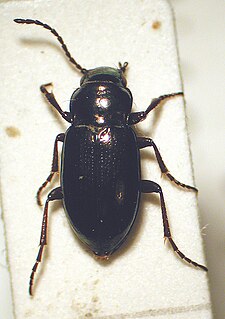
The Trachypachidae are a family of beetles that generally resemble small ground beetles, but that are distinguished by the large coxae of their rearmost legs. There are only six known extant species in the family, with four species of Trachypachus found in northern Eurasia and northern North America, and two species of Systolosoma in Chile. They were much more diverse in the past, with many members belonging to the extinct subfamily Eodromeinae, the first fossils known of this family are of the genera Petrodromeus and Permunda from the Permian-Triassic boundary of Russia.

Pselaphinae are a subfamily of beetles in the family Staphylinidae, the rove beetles. The group was originally regarded as a separate family named Pselaphidae. Newton and Thayer (1995) placed them in the Omaliine group of the family Staphylinidae based on shared morphological characters.
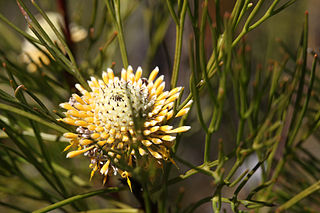
Isopogon anethifolius, commonly known as narrow-leaf drumsticks or narrow-leafed drumsticks, is a shrub in the family Proteaceae. The species is found only in coastal areas near Sydney in New South Wales, and to the immediate west. It occurs naturally in woodland, open forest and heathland on sandstone soils. An upright shrub, it can reach to 3 m (10 ft) in height, with terete leaves that are divided and narrow. The yellow flowers appear in the Spring, from September to December, and are prominently displayed. They are followed by round grey cones, which give the plant its common name of drumsticks. The small hairy seeds are found in the old flower parts.

The Chrysomelinae are a subfamily of leaf beetles (Chrysomelidae). Some 2000 species are found, with worldwide distribution. The best-known member is the notorious Colorado potato beetle, an important agricultural pest.

The Eumolpinae are a subfamily of the leaf beetles, or Chrysomelidae. It is one of the largest subfamilies of leaf beetles, including more than 500 genera and 7000 species. They are oval, and convex in form, and measure up to 10 mm in size. Typical coloration for this subfamily of beetles ranges from bright yellow to dark red. Many species are iridescent or brilliantly metallic blue or green in appearance.

The rose robin is a small passerine bird native to Australia. Like many brightly coloured robins of the Petroicidae, it is sexually dimorphic. The male has a distinctive pink breast. Its upperparts are dark grey with white frons, and its tail black with white tips. The underparts and shoulder are white. The female is an undistinguished grey-brown. The robin has a small black bill and eyes.

The fawn leaf-nosed bat – Hipposideros cervinus – is a species of bat in the family Hipposideridae found in Australia, Indonesia, Malaysia, the Philippines and Vanuatu.

The orange leaf-nosed bat is a bat in the family Hipposideridae. It is the only living species in the genus Rhinonicteris which is endemic to Australia, occurring in the far north and north-west of the continent. They roost in caves, eat moths, and are sensitive to human intrusion.

The broad-tailed gecko, southern leaf-tailed gecko, or Sydney leaf-tailed gecko is a common gecko of the family Carphodactylidae found in the Sydney Basin. The species uses its mottled colour to camouflage against bark or rock, and if threatened can drop its large fleshy tail as a decoy. The tail is also useful for fat storage. This species of gecko is available in captivity as a pet, they are a nocturnal ambush hunter, relying on camouflage and patience to catch prey. Primary prey items include large nocturnal invertebrates such as spiders, cockroaches and beetles.

Androcalva fraseri, commonly known as blackfellow's hemp or brush kurrajong is a common shrub or small tree of the mallow family found in eastern Australia. Growing up to 8 metres tall, it is found in rainforest margins and in wet eucalyptus forests.

Chrysomela is a genus of leaf beetles found almost throughout the world, but not in Australia. It contains around 40 species, including 7 in eastern and northern Europe. It also includes at least 17 species in North America, including the cottonwood leaf beetle Chrysomela scripta.

Paropsides is a genus of beetles commonly called leaf beetles and in the subfamily Chrysomelinae. They are distributed from eastern Asia to eastern Australia. Paropsides are small and specialist feeders on native Australian plants. There are 21 species in Australia and they occur mainly on the south-eastern states. The green Paropsides calypso is a native species which commonly attacks the lillipilli genus Syzygium. Paropsides opposita feeds on Tea tree Melaleuca sp.
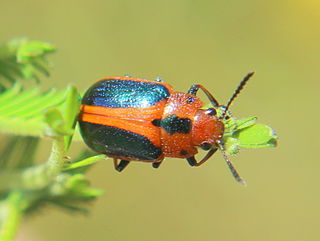
Calomela is a genus of beetles commonly called leaf beetles and in the family Chrysomelidae. They are specialist feeders on various species of Acacia and are not reported as a problem species. The beetles are cylindrical when compared with other leaf beetles and their larvae are globose. Calomela include about 45 species and are found in all states of Australia
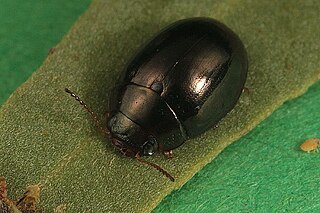
Geomela is a genus containing several small dark beetles in the family Chrysomelidae . They are flat when compared with other leaf beetles. There are 13 species which occur mainly in the southeastern parts of Australia.

Cadmus is a genus of leaf beetles which are commonly called case bearing leaf beetles in the subfamily Chrysomelinae. They are widespread throughout Australia and include 5 subgenera and 68 species.
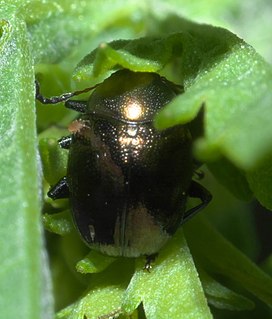
Eumolpini is a tribe of leaf beetles in the subfamily Eumolpinae. It is the largest tribe in the subfamily, with approximately 170 genera found worldwide. Members of the tribe almost always have a longitudinal median groove on the pygidium, which possibly helps to keep the elytra locked at rest. They also generally have a subglabrous body, as well as appendiculate pretarsal claws.




















